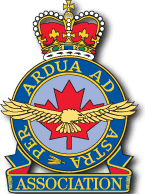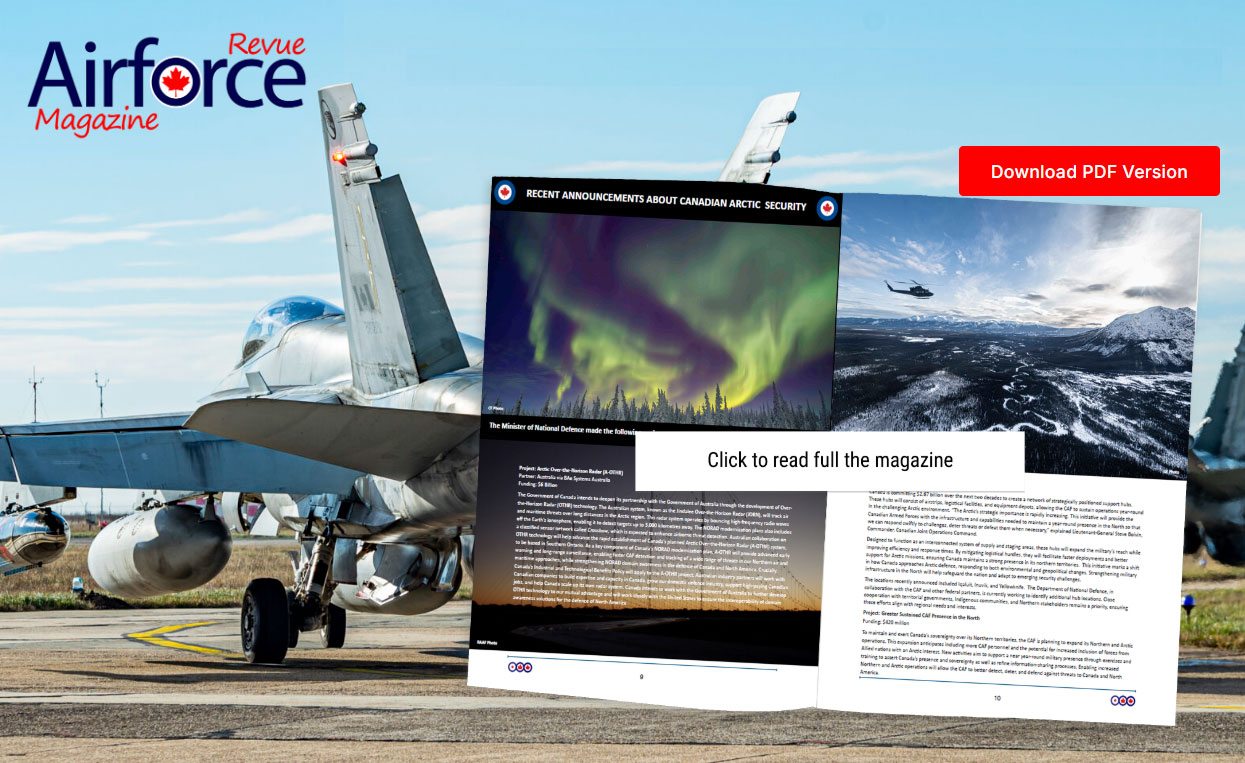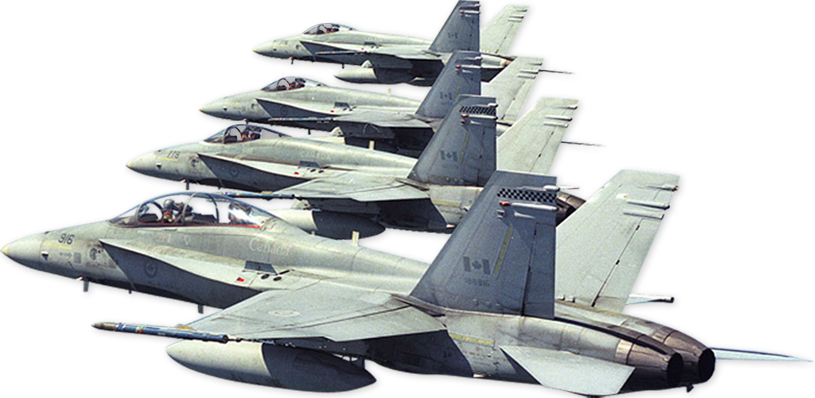1939
17 February
A detachment from No. 1 (F) Squadron at Calgary went to Sea Island to take delivery of the first Hawker Hurricane fighters issued to replace the long-obsolete Siskins. On 1 June S/L EG Fullerton ferried the first Hurricane from Vancouver to the squadron base at Calgary.
May to June
During the visit of Their Majesties the King and Queen, the RCAF provided aerial escorts and guards of honour. Three Stranraers escorted the Royal Yacht up the St. Lawrence on its arrival at Quebec, escorted RCN ships conveying the Royal Party to Prince Edward Island, and again escorted the Royal Yacht on its departure from Halifax. At Trenton five Wapiti and three Atlas aircraft flew on escort, and at Vancouver three Stranraers and five Hurricanes escorted Their Majesties on the trip to Victoria and back. While the King and Queen were in residence at Ottawa the RCAF provided the Royal Household Guard.
26 August
RCAF squadrons began moving to war stations. No .. 3 (B) Squadron’s Wapitis left Calgary en route to Halifax, followed five days later by No. 1 (F) Squadron en route to St Hubert. No. 2 (AC) Squadron began to move from Trenton to Halifax and thence to Saint John. No. 8 (GP) Squadron, after recalling its aircraft from detached photographic operations, left Ottawa for Sydney.
31 August
On the eve of the war the RCAF total strength was 4,061 officers and airmen (Permanent – 298 officers, 2,750 airmen; Auxiliary – 112 officers, 901 airmen). It had 270 aircraft of 28 different types; “service” types included twenty-two Wapitis, twenty Oxfords, nineteen Hurricanes, thirteen Atlas, twelve Deltas, eleven Sharks, ten Battles, nine Stranraers, five Siskins, four Norsemen and four Vancouvers.
The organization of the Force was:
- Headquarters and Record Office, Ottawa
- Western Air Command, Vancouver
- Eastern Air Command, Halifax
- Air Training Command, Toronto
Stations
- Vancouver
- Dartmouth
- Ottawa (Photo Establishment, Test & Development Flight, Communication Flight)
- Camp Borden (Intermediate Training Wing Headquarters, Intermediate Training Squadron, Intermediate Ground Instructional School; No. 2 Technical Training School)
- Trenton (Advanced Training Wing Headquarters, Advanced Training Squadron, Advanced Ground Instructional School; No. 1 Technical Training, Air Armament, Equipment Training, Air Navigation and Seaplane, and Wireless Schools).
Squadrons (Permanent)
- No. 1 (F) – Hurricane; en route St. Hubert
- No. 2 (AC) – Atlas; Saint John, NB
- No. 3 (B) – Wapiti, en route Halifax
- No. 4 (GR) – Vancouver and Stranraer; Vancouver
- No. 5 (GR) – Stranraer; Dartmouth
- No. 6 (TB) – Shark; Vancouver
- No. 7 (GP) – Fairchild and Norseman; Ottawa
- No. 8 (GP) – Delta; Sydney
- Nos. 9, 10 and 11 Squadrons had also been authorized, but not formed prior to 1 September.
Depots
- No. 1 Aircraft, Ottawa
- No. 2 Equipment, Winnipeg
- No. 3 Repair, Vancouver
- No. 4 Repair, Dartmouth
- No. 5 Equipment, Moncton
Detachments
- No. 11 (Technical), Montreal
- No. 12 (Technical), Toronto
- No. 13 (Technical), Vancouver
- No. 21 (Magazine), Kamloops
- No. 22 (Magazine), Debert
Auxiliary Active Air Force
Wing Headquarters
- No. 100, Vancouver
- No. 101, Toronto
- No. 102, Montreal
Squadrons
- No. 110 (AC), Toronto
- No. 111 (CAC), Vancouver
- No. 112 (AC), Winnipeg
- No. 113 (F), Calgary
- No. 114 (B), London
- No. 115 (F), Montreal
- No. 116 (F), Halifax
- No. 117 (CAC), Saint John
- No. 118 (B), Montreal
- No. 119 (B), Hamilton
- No. 120 (B), Regina
- No. 121 (F), Quebec City
Each of the 12 Auxiliary squadrons had a PF Detachment. Five squadrons (Nos. ·113, 114, 116, 117 and 121) were still in preliminary stages of organization and were disbanded after the outbreak of hostilities.
Summary to 31 August
Prior to the declaration of war considerable progress was made in the establishment or improvement of bases on the Pacific and Atlantic coasts. An Equipment Depot was opened at Moncton and a magazine at Debert. The meteorological service of the Department of Transport was extended to the east coast, and plans were made for a complete service for all Air Force establishments. Improvement of Service armament was actively pursued; a Directorate of Armament was formed at Headquarters, the Air Armament School at Trenton was expanded, and the armament on all service aircraft was modernized. An Intelligence Section was ·also organized.
Service flying training for the period 1 April to 31 August totalled 11,924.15 hours (7,104.20 by Permanent units and 4,819.55 by Auxiliary squadrons, including
a fortnight in annual summer camp). As arranged the previous year, elementary training was carried out at civil flying clubs; intermediate training was given at Camp Borden and advanced at Trenton. To train civil elementary instructors a Flying Instructors’ School was opened at Camp Borden early in the year.
Civil Government air operations consisted of aerial photography and survey for the Dominion Forest Service and the Bureau of Geology and Topography. One detachment of three aircraft was assigned in July to make a detailed reconnaissance of the Labrador coast. The work was interrupted, however, when the aircraft had to be sent on a search for a civil machine lost in Labrador. All photographic work was suspended on 25 August. By that date 424.35 hours’ flying had been recorded and 25,100 square miles photographed.
1 September
Germany attacked Poland. The RCAF was placed on active service.
Great Britain and France declared war on Germany.
P/O Selby R Henderson, a Canadian in No. 206 Squadron, RAF, was the lead navigator in a bomber force attacking German warships. He thus became the first Canadian to participate on an operational sortie in the Second World War.
10 September
Canada declared war on Germany.
By Order-in-Council the RCAF Special Reserve was created and placed on active service.
14 September
En route from Megantic, PQ to Sydney, NS to take up wartime duties, a Delta Mk II serial no. 673 (formerly a Northrop Gamma) reconnaissance aircraft disappeared. The wreckage of the machine was located in New Brunswick in 1958, nineteen years after crashing, but there was no sign of its crew, FS JE Doan and LAC DA Rennie. (Mr. Joseph Nelles authored a two-page story titled “First Lost…Last Found” published in Airforce magazine Volume 19, No 4, pp 3-4, – January 1996 – that tells the full story of Canada’s first casualties of the Second World War. If you would like a copy of the story write to director at airforce.ca by e-mail).
The Directorate of Air Force Manning was formed at Headquarters to direct the rapid expansion of the Force and 20 recruiting centres were opened across the Dominion. By the end of the fiscal year (31 March, 1940), 102,777 applications had been received.
RCAF Manning Pool (later No. 1 Manning Depot) was formed at Toronto.
S/L William Isaac Clements, attached to No. 53 (Blenheim) Squadron, RAF, made a long distance night reconnaissance from Metz, France, to the Hamm-Hanover area of Germany – the first member of the RCAF to fly over enemy territory.
Formation of the Organization and Training Division at Headquarters was authorized, to carry out the proposed training plan. (Headquarters now constituted four Divisions – Air Staff, Personnel, Aeronautical Engineering and Supply, and Organization and Training – each under an Air Member. The new “Air Member” titles were introduced 21 October).
The governments of the United Kingdom, Canada, Australia and New Zealand signed, at Ottawa, an agreement to set up a British Commonwealth Air Training Plan organized and administered-by the RCAF (acting for the Canadian Government). The initial plan proposed the establishment of three Initial Training Schools, thirteen Elementary Flying Training Schools, sixteen Service Flying Training Schools, ten Air Observer Schools, ten Bombing and Gunnery Schools, two Air Navigation Schools and four Wireless Schools, plus the necessary ancillary schools and depots, a total of 74 units in all.
Training was to begin on 29 April 1940 and all schools were to be in operation by 30 April 1942. When fully developed the Plan was to produce 520 pilots with elementary training, 544 pilots with service training, 340 observers and 580 wireless operator-air gunners every four weeks.
The strength of the RCAF_at the end of the year totalled 8,287 officers and airmen, an increase of more than 100 per cent in four month. There were 280 Permanent, 195 Auxiliary and 454 Special Reserve Officers and 7,358 airmen.
The operational strength was fourteen squadrons, all stationed in Canada: No. 1 (F) Dartmouth, No. 4 (BR) Vancouver, No. 5 (BR) Dartmouth, No. 6 (BR) Vancouver, No. 8 (BR) North Sydney, No. 10 (BR), formed from No. 3 on 5 September, Halifax, No. 11 (BR) Dartmouth, No. 110 (AC) Ottawa, No. 111 (CAC) Vancouver, No. 112 (AC) Ottawa, No. 115 (F) St. Hubert, No. 118 (B) Dartmouth, No. 119 (B) Hamilton and
No. 120 (BR) Vancouver.
1940
RCAF Overseas Headquarters, London, England, was formed under W/C FV Heakes who had been RCAF Liaison Officer. On 7 March G/C MV Walsh, MBE, assumed command.
2 January
The London Gazette announced that P/O SR Henderson and W/C JF Griffiths, two Canadians in the RAF, had been awarded the Distinguished Flying Cross for air operations against the enemy, the first Canadians to be decorated during the war. P/O Henderson’s award was for attacking German flying boats on 8 November 1939. W/C Griffiths was decorated for attacks on German warships on 14 December 1939.
14 February
No. 110 (AC) Squadron, augmented by personnel of No. 2 (AC) Squadron, sailed from Halifax, under the command of S/L WB Van Vliet. It disembarked at Liverpool on 25 February, the first of 48 RCAF squadrons which served overseas during the war.
16 February
The prewar Wireless School was transferred from Trenton to Montreal and re-named No. 1 Wireless School, the first of four such schools operated within the BCATP.
31 March
In the fiscal year, 1 April 1939-31 March 1940, the RCAF flew 69,472.50 hours, including 5,022.10 hours on service operations and 60,316.30 hours on training at civil flying clubs, service schools and units. The balance (4,134.10 hours) covered testing, transfer of aircraft, transportation, Civil Government operations (prior to 25 August 1939), co-operation with the Militia and miscellaneous duties.
March to April
To implement the BCATP four Training Commands were organized. Air Training Command (Toronto) was re-designated No. 1 TC on 1 January; No. 2 TC formed at Winnipeg on 15 April, No. 3 TC at Montreal on 18 March and No. 4 TC at Regina on 29 April.
15 April
No. 1 Initial Training School was officially opened in the Eglinton Hunt Club, Toronto, absorbing the Ground Training School previously located at Trenton. The first intake of BCATP trainees, 164 AC2s, arrived on 29 April.
29 April
No. 1 Air Navigation School was formed at Trenton, providing specialized training in this field for BCATP students.
21 May
An advance party of No. 112 (AC) City of Winnipeg Squadron sailed from Montreal, and disembarked at Liverpool eight days later.
23 May
Hon CG Power, KC, MC, was appointed Minister of National Defence for Air.
23 to 25 May
On 23 May S/L FM Gobeil, an RCAF exchange officer commanding No. 242 (Canadian) Squadron of the RAF, engaged a Bf.109 near Berek, France. Two days later this officer, in another combat near Menin, Belgium, shot down a Me. 110.
27 May
No. 1 Air Observer School was officially opened at Malton with the first intake of BCATP trainees. All AOSs were operated by civilian firms under RCAF supervision.
8 June
No. 1 (F) squadron, augmented by personnel of No. 115 (F) Squadron, under the command of S/L EA McNab, and the rear party of No. 112 (AC) Squadron, commanded by S/L WF Hanna, sailed from Halifax and arrived at Liverpool on 20 June.
17 June
No. 10 (BR) Squadron at Dartmouth sent a detachment of five Douglas Digbys, under the connnand of S/L HM Carscallen, to operate from Newfoundland Airport
(Gander).
20 June
An Air Council was constituted to advise the Minister of National Defence for Air.
24 June
The first four Elementary Flying Training Schools (No. 1 at Malton, No. 2 at Fort William, No. 3 at London and No. 4 at Windsor Mills, PQ) were officially
opened with intakes of 24 BCATP pupil-pilots. The EFTSs were operated mainly by civilian companies with RCAF supervisory staffs. An exception was the EFTS at Cap de la Madeleine, operated by Quebec Airways.
June
The RCAF ensign was approved by HM the King. It was adapted from the RAF ensign with the substitution of a red maple leaf for the red circle in the centre of the roundel.
22 July
The first intake of BCATP pupils for service flying training reported to No. 1 Service Flying Training School at Camp Borden. The school had been formed earlier in the year from the training units operating there.
15 August
S/L EA McNab, while flying with No. 111 Squadron, RAF, destroyed a Do. 215 and won the RCAF’s first victory in the Battle of Britain.
17 August
No. 1 (F) Squadron (later No. 401) became operational on its Hurricane aircraft and began patrols and scrambles over its base at Northolt.
19 August
No. 1 Bombing and Gunnery School was formed at Jarvis, Ontario, the first of eleven such schools formed within the BCATP to train bomb aimers and air gunners for the RCAF and Commonwealth Air Forces.
21 August
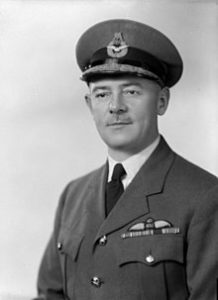
By Order in Council the Permanent Joint Board of Defence was formed to co-ordinate Canadian and American activities relating to the defence of North America. Composed of civilians and personnel from all services of both countries, the Board held its first meeting on 26 August. Many of its subsequent meetings dealt with air force matters, including the Northwest Staging Route, anti-submarine operations, and supplies of aircraft. The first RCAF representative on the Board was A/C Albert Abraham Lawson Cuffe (pictured above). To learn more about Air Commodore Cuffe, consult this link here.
21 August
Intercepting a raid by 25 or 30 Dornier bombers, No. 1 Squadron destroyed three and damaged four. F/0 RL Edwards was killed in the engagement – the RCAF’s first battle casualty. No. 1 remained in the Battle of Britain until 9 October when it was withdrawn for a rest. In the 53-day period, 17 August to 9 October, it was credited with destroying 30 enemy aircraft and damaging 43 more. Three pilots were killed in action and ten wounded or injured.
22 October
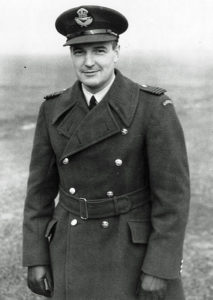
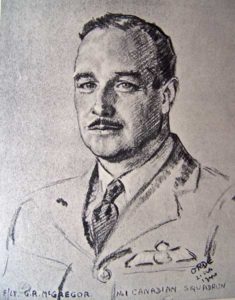
S/L EA McNab, commanding officer of No. 1 (F) Squadron, was awarded the Distinguished Flying Cross for his services in the Battle of Britian. Three days later F/L Gordon Roy McGregor (pictured) and F/O BD Russel of the same squadron also received the DFC. (To learn more about McGregor, visit this link, here).
8 November
Training and Supply were detached from AMOT and AMAES respectively and became separate divisions under Air Members. An Order in Council authorized the formation of the Air Cadet League of Canada, a civilian organization to train boys of 12 to 18 years of age for possible future enlistment in the RCAF.
24 November
The first draft of BCATP graduates, 12 officers and 25 sergeant observers, arrived at Liverpool. The course of 37 had graduated from No. 1 Air Navigation School at Trenton on 24 October.
31 December
There were three RCAF squadrons overseas: No. 1 (F), No. 110 (AC) and No. 2 (F) which had just been formed from No. 112 (AC) Squadron. At home there were eleven squadrons: in EAC – Nos. 5, 10 and 11 (BR) at Darmouth, No. 8 (BR) at North Sydney and No. 119 (BR) at Yarmouth; in WAC – No. 4 (BR) at Ucluelet, No. 6 (BR) at Coal Harbour, and Nos. 111 (F), 120 (BR) and 13 (Operational Training) at Patricia Bay; No. 12 (Communication) Squadron was stationed at Rockcliffe.
1941
7 January
Article 15 of the Agreement of 17 December, 1939, provided that “pupils of Canada, Australia and New Zealand shall, after training is completed, be identified with their respective Dominions, either by the method of organizing Dominion units and formations or in some other way.” By the supplementary Sinclair-Ralston agreement signed in London on 7 January, 1941, it was arranged that 25 RCAF squadrons would be formed in the UK in the next 18 months (exclusive of the original three sent over from Canada).
To obviate confusion with RAF units, squadrons of the RCAF overseas were re-numbered in the 400 series. Thus No. 110 became No. 400; No. 1 became No. 401, and No. 112 which had been reorganized as No. 2 (F) Squadron, became No. 402. On the same date No. 402 was passed as operational, the second RCAF fighter squadron to go into action overseas. No. 403 (F) Squadron, the first of the “Article 15” units, was formed at Baginton, England. It was followed by 17 more in the next ten months, these being:
- No. 404 (Coastal Fighter) 15 April
- No. 405 (Bomber) 23 April
- No. 407 (Coastal) 8 May
- No. 406 (Night Fighter) 10 May
- No. 411 (Fighter) 16 June
- No. 409 (Night Fighter) 17 June
- No. 408 (Bomber) 24 June
- No. 410 (Night Fighter) 30 June
- No. 412 (Fighter) 30 June
- No. 413 (Coastal) 1 July
- No. 414 (Army Co-operation) 12 August
- No. 415 (Coastal) 20 August
- No. 418 (Intruder) 15 November
- No. 416 (Fighter) 18 November
- No. 417 (Fighter) 27 November
- No. 419 (Bomber) 7 December
- No. 420 (Bomber) 19 December
Of these, Nos. 403 to 413 inclusive had started operations by the end of the year.
11 April
No. 10 (BR) Squadron, which had had a flight at Gander since June, 1940, moved to the Newfoundland airport.
15 April
Twelve pilots of No. 402 Squadron, led by W/C GR McGregor, DFC, took part in an offensive patrol over the Boulogne sector of the French coast. This was the first offensive operation carried out by an RCAF unit over enemy-held territory.
23 May
Operational training in Canada commenced with the opening of No. 31 Operational Training Unit at Debert, NS. Equipped with Hudson and Bolingbroke aircraft, the unit was the first of ten OTUs to be located in Canada under RAF and RCAF control.
Three Vickers Wellington bombers of No. 405 Squadron carried out the RCAF’s first attack on Germany, bombing the freight yards at Schwerte, southeast of Dortmund, with a total of 9,000 lbs of high explosives and 2,160 lbs of incendiaries for the three aircraft.
2 July
The formation of a Canadian Women’s Auxiliary Air Force was authorized by Order in Council, to recruit women for training in various ground trades so that men could be released for combat duties. By the end of the war it had enrolled 17,038 women, of whom over 1,500 saw service overseas. The first female officer was Kathleen Walker, appointed Flight Officer, 2 July; the first airwoman was Jane Bennett.
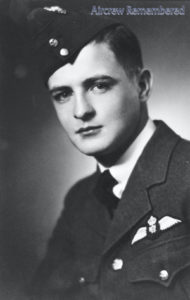
PL-6819 23 February 1942
Sgt. Joseph Laurent Guillaume Robillard (DFC)
While flying a Spitfire with No. 145 Squadron (RAF) FS JGL Robillard was shot down over France. Making contact with French civilians, he evaded capture and reached Gibraltar by the end of October. He subsequently returned to operational duties. FS Robillard was the first RCAF airman to become a successful “evader”. (Learn more here at this link).
22 July
A Catalina of No. 116 Squadron, captained by F/L NE Small, attacked a U-boat, but the bombs did not explode.
1 to 2 September
F/O RC Fumerton and Sgt LPS Bing, flying a Beaufighter of No. 406 Squadron, won the RCAF’s first night fighter victory by destroying a Ju. 88 over Bedlington, Northumberland.
22 September
Formation of University Air Training Squadrons was proposed and approved.
23 October
The Manning Depot for womn personnel opened at Havegal College, Toronto, with 150 airwomen taking administrative courses. The depot was subsquently redesignated No. 6 Manning Depot.
10 November
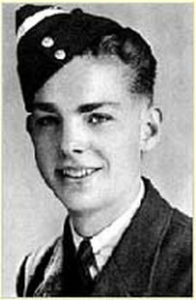
Despite serious injuries, which proved fatal, LAC KM Gravell, a wireless operator-air gunner under training at No. 2 Wireless School, Calgary, gallantly
endeavoured to rescue his pilot from the blazing wreckage of their crashed Tiger Moth aircraft. His gallantry and self-sacrifice were recognized by the posthumous award of the George Cross.
7 December
Canada declared war on Japan, and immediate steps were taken to strengthen our Pacific defences. The formation of new squadrons was instituted and others were shifted from EAC to WAC.
21 December
No. 404 (Blenheim) Squadron helped to provide longrange fighter cover for Commando forces attacking enemy positions at Vaagso (Norway).
31 December
There were 21 RCAF squadrons in the United Kingdom and 16 at home. Of the overseas squadrons, 14 were operational (five fighter, three night fighter, one army co-operation, two bomber and three coastal). In EAC there were Nos. 5 (BR), 11 (BR), 116 (BR), (formed 28 June) and 118 (F) at Dartmouth, No. 8 (BR) at North Sydney, No. 119 (BR) at Yarmouth, and No. 10 (BR) at Gander, Nfld. In WAC Nos. 13 (Operational Training), 111 (F), and 115 (F), (formed 1 August) were at Patricia Bay; No. 4 (BR) was at Ucluelet, No. 6 (BR) at Alliford Bay, No. 120 (BR) at Coal Harbour, No. 7 (BR), (formed 8 December) at Prince Rupert, and No. 9 (BR), (formed 8 December) at Bella Bella. No. 12 (Comm) Squadron was still at Rockcliffe.
1942
2 January
Trained members of the CWAAF began reporting to units in Canada. No. 2 SFTS, Uplands, was the first station to receive such personnel, who were initially posted to BCATP stations.
3 February
The Canadian Women’s Auxiliary Air Force was renamed Royal Canadian Air Force (Women’s Division).
12 February
The Scharnhorst, Gneisenau and Prinz Eugen escaped from Brest, where they had been frequently attacked by RCAF units of Bomber Command, and fled up the Channel and through the Strait of Dover under attack by aircraft of the Fleet Air Arm and Coastal, Bomber and Fighter Commands of the RAF. Nine Canadian squadrons (four bomber, four fighter and one coastal) took part in the day’s action; seven aircraft were lost and three enemy fighters were destroyed and three damaged.


